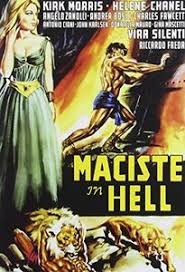
In Scotland, in 1522 Marta Gant is burned at the stake for witchcraft. She is condemned by Judge Parris (Andrea Bosic). Before she dies she condemns the village of Looklake. A hundred years later the women of the village go insane and try to commit suicide by hanging themselves from an old dead tree near where Marta was burned. Each time the tree claims a victim, a bloom appears on the tree.
A descendant of the witch, also named Marta Gant (Vira Silenti), marries Charlie Loove (Angelo Zanolli). Unaware of the family history Charlie buys the castle that once belonged to the Gant family as a wedding present for his new wife. When the villagers hear that Marta is back they believe she is the original witch who has returned to destroy the village. Pitchforks and torches in hand the villagers rush up to the castle. They grab Marta and prepare to hang her. Into the brouhaha comes Maciste (Kirk Morris). He beats up a bunch of villagers and saves Marta’s life.
Marta is put on trial. When she is told to swear on the bible that she never performed magic the bible bursts into flame. Marta is condemned to death. She is to be burned to death at the stake. Maciste goes to the dead tree near where the original Marta Gant was killed and pulls it up by the roots. Underneath the tree he finds a passageway to hell. Maciste descends into hell. He must overcome a series of obstacles to find the original witch that cursed the village. Only when she is destroyed will the insane become whole again and the curse lifted.
“Maciste all'inferno” or “Maciste in Hell” AKA “The Witch’s Curse” was released in 1962 and was directed by Riccardo Freda. It is an Italian sword and sandal film that takes place in seventeenth century Scotland. It is a mixture of peplum and gothic witch burning.
There are a few versions of the film out there. The American version, which was called “The Witch’s Curse”, is about fifteen minutes shorter than the original Italian version and is dubbed into English. There is also a version that is longer which was the American dubbed version with the cut parts restored. Some of the restored portions are in Italian with English subtitles and some parts are just in Italian. It seems there were bits where they forgot about the subtitles. There is also another version that is the original Italian version subtitled in English. That’s the best one. The American dubbed version is in really bad shape. The American dubbed with the bits put back in is better. The original Italian version is clear and the colors are wonderful. It also contains some additional obstacles in Maciste’s journey through hell.
If you are watching the original Italian version, is actually quite good. Once you get to the point where Maciste is in hell is where all the wonderful sights and battles happen. It is a totally different quality of film when compared to the campy Americanized version. “Maciste in Hell” is not exactly an original film. It’s sort of a quasi remake of the Italian silent film, also called “Maciste in Hell” that was done in 1925 by director Guido Brignone.
The underground scenes were filmed at the Castellana Caves. They are a well known tourist attraction in southern Italy. The dubbing of the film was done in Italy. The Italians maintained the Maciste name when they translated the movie. This is one of the few peplum films that use the Maciste name for the American release. Usually the U.S. changed his name to something more familiar to American audiences, such as Hercules. There is also a little stock footage from other sword and sandal movies in the section of the film where Prometheus is helping Maciste regain his memory. They show how Maciste is a hero who stops evil across the eons of time. Looking at it that way it makes more sense having Maciste in seventeenth century Scotland. It’s really a great movie with a lot of wonderful imagery.

